Denbighshire: Difference between revisions
No edit summary |
|||
| (25 intermediate revisions by 2 users not shown) | |||
| Line 2: | Line 2: | ||
|name=Denbighshire | |name=Denbighshire | ||
|welsh=Sir Ddinbych | |welsh=Sir Ddinbych | ||
|map image= | |map image=Denbighshire Brit Isles Sect 6.svg | ||
|picture= | |picture=Cefn castell - geograph.org.uk - 156229.jpg | ||
|picture caption= | |picture caption=Cefn Castell | ||
|county town=[[Denbigh]] | |county town=[[Denbigh]] | ||
}} | }} | ||
The '''County of Denbigh''' is a [[Counties of the United Kingdom|shire]] in northern [[Wales]]. It is a maritime county, bounded to the north by the [[Irish Sea]], to the east by [[Flintshire]], [[Cheshire]] and [[Shropshire]], to the south by [[Montgomeryshire]] and [[Merionethshire]], and to the west by [[Caernarfonshire]]. | |||
[[Denbigh]], after which the county is named, is the [[county town]], but the largest town is the industrial town of [[Wrexham]] at the south-east edge of the shire, near the [[Shropshire]] border. All along the coast are nineteenth-century seaside resorts, such as [[Colwyn Bay]], and these continue as such today. | |||
{{ | The most important industries in Denbighshire are agriculture and tourism. | ||
==Geography== | |||
[[File:Pistyll Rhaeadr 0073.JPG|left|thumb|170px|Pistyll Rhaeadr]] | |||
In the south and west of the county are high mountains of the Cambrian range. The hills of the Clwydian Range in the east of the shire rise from 1,000 to 2,500-feet high. There is in contrast a broad coastal plain on which many of the county's towns are found, and its famed seaside resorts. | |||
The county top is the south summit of [[Cadair Berwyn]], standing at 2,726 feet above sea level in the [[Cambrian Mountains]], approaching [[Snowdonia]], and it is in these hills that Denbighshire's highest mountains are found. Either side of the county top itself and on the same ridge are two summits mapped at equal height; Cadair Berwyn and Moel Sych to the south on the same ridge both at 2,713 feet. | |||
The hills of the Clwydian Range are far more gentle but it is from these hills tumbles [[Pistyll Rhaeadr]], a spectacular 240-foot waterfall, the highest in Wales. On the ridge of these hills runs the border with [[Flintshire]]. | |||
In the south the [[Clocaenog Forest]] reaches its highest and wildest on the [[Denbigh Moors]] or Mynydd Hiraethog. | |||
The chief rivers of Denbighshire are the [[River Clwyd]] and the [[River Dee]]. The [[River Conwy]] runs north along the western border. | |||
The broad, fertile Vale of Clwyd runs south to north at the west side of Denbighshire. | |||
[[File:Denbighshire Hundreds.svg|thumb|300px|The hundreds of Denbighshire]] | |||
The county is divided into six hundreds: | |||
*[[Bromfield Hundred|Bromfield]] | |||
*[[Chirk Hundred|Chirk]] | |||
*[[Isaled Hundred|Isaled]] | |||
*[[Isdulas Hundred|Isdulas]] | |||
*[[Ruthin Hundred|Ruthin]] | |||
*[[Yale Hundred|Yale]] | |||
==History== | |||
[[File:Eliseg's Pillar - geograph.org.uk - 206975.jpg|right|thumb|190px|Eliseg's Pillar]] | |||
The Romans were here; they had a fort at [[Abergele]]. | |||
After the Roman retreat, these lands fell to the Kingdoms of [[Powys]] and [[Gwynedd]]. One remarkable remaining monument of the Sub-Roman period is the Pillar of Eliseg, near Valle Crucis Abbey ({{getmapecho|SJ204442}}) erected by Cyngen ap Cadell King of Powys (died 855), in honour of his great-grandfather Elisedd ap Gwylog, the inscription of which mentions several individuals described in the ''Historia Britonum'' and give a brief history of the deeds of the dynasty. | |||
After the English conquest of North Wales, Denbighland was divided into marcher lordships: Bromfield and Yale, Chirk, Denbigh and Ruthin (Dyffryn Clwyd) | |||
The ''County or Shire of Denbigh'' was formally created by the Laws in Wales Acts 1535-1542, out of the lands long known as "Denbighland".<ref>[http://owain.vaughan.com/1535c26/ Laws in Wales Act 1535], [http://owain.vaughan.com/1542c26/ Laws in Wales Act 1542]</ref> | |||
Within the county are the following historic cantrefs: | |||
*From the Kingdom of [[Gwynedd]]: | |||
**Rhos | |||
**Rhufoniog | |||
**Dyffryn Clwyd | |||
*From Powys Fadog: | |||
**Iâl | |||
**Maelor Gymraeg | |||
**Nanheudwy | |||
**Cynllaith | |||
==Towns and villages== | |||
[[File:Panorama of Denbigh Castle from Moor - geograph.org.uk - 773171.jpg|right|thumb|220px|The county town, Denbigh]] | |||
The towns of Denbighshire are: | |||
===Cities=== | |||
*[[Wrexham]] | |||
===Towns=== | |||
*[[Abergele]] | |||
*[[Colwyn Bay]] | |||
*[[Denbigh]] | |||
*[[Llangollen]] | |||
*[[Llanrwst]] | |||
*[[Ruthin]] | |||
===Civil communities=== | |||
{{parishliststart}} | |||
*[[Abenbury]] | |||
*[[Abergele]] | |||
*[[Aberwheeler]] | |||
*[[Acton, Denbighshire|Acton]] | |||
*[[Betws Yn Rhos]] | |||
*[[Bro Garmon]] | |||
*[[Brymbo]] | |||
*[[Bryneglwys]] | |||
*[[Caia Park]] | |||
*[[Cefn, Denbighshire|Cefn]] | |||
*[[Cefnmeiriadog]] | |||
*[[Ceiriog Ucha]] | |||
*[[Cerrigydrudion]] | |||
*[[Chirk]] | |||
*[[Clocaenog]] | |||
*[[Coedpoeth]] | |||
*[[Colwyn Bay]] | |||
*[[Cyffylliog]] | |||
*[[Denbigh]] | |||
*[[Derwen]] | |||
*[[Efenechtyd]] | |||
*[[Eglwysbach]] | |||
*[[Erbistock]] | |||
*[[Esclusham]] | |||
*[[Glyntraian]] | |||
*[[Gresford]] | |||
*[[Gwersyllt]] | |||
*[[Henllan]] | |||
*[[Holt, Denbighshire|Holt]] | |||
*[[Isycoed]] | |||
*[[Kinmel Bay and Towyn]] | |||
*[[Llanarmon-yn-Ial]] | |||
*[[Llanbedr Dyffryn Clwyd]] | |||
*[[Llanddulas and Rhyd-y-Foel]] | |||
*[[Llandegla]] | |||
*[[Llandyrnog]] | |||
*[[Llanelidan]] | |||
*[[Llanfair Dyffryn Clwyd]] | |||
*[[Llanfair Talhaiarn]] | |||
*[[Llanferres]] | |||
*[[Llanfihangel Glyn Myfyr]] | |||
*[[Llangedwyn]] | |||
*[[Llangernyw]] | |||
*[[Llangollen]] | |||
*[[Llangollen Rural]] | |||
*[[Llangwm, Denbighshire|Llangwm]] | |||
*[[Llangynhafal]] | |||
*[[Llannefydd]] | |||
*[[Llanrhaeadr-ym-Mochnant]] | |||
*[[Llanrhaeadr-Yng-Nghinmeirch]] | |||
*[[Llanrwst]] | |||
*[[Llansanffraid Glan Conwy]] | |||
*[[Llansannan]] | |||
*[[Llansantffraid Glyn Ceiriog]] | |||
*[[Llansilin]] | |||
*[[Llantysilio]] | |||
*[[Llanynys]] | |||
*[[Llay]] | |||
*[[Llysfaen]] | |||
*[[Marchwiel]] | |||
*[[Minera]] | |||
*[[Mochdre, Denbighshire|Mochdre]] | |||
*[[Nantglyn]] | |||
*[[Offa]] | |||
*[[Old Colwyn]] | |||
*[[Pentrefoelas]] | |||
*[[Penycae]] | |||
*[[Rhos-on-Sea]] | |||
*[[Rhosddu]] | |||
*[[Rhosllanerchrugog]] | |||
*[[Rossett]] | |||
*[[Ruabon]] | |||
*[[Ruthin]] | |||
*[[Sesswick]] | |||
*[[Trefnant]] | |||
{{parishlistend}} | |||
==Things to see in Denbighshire== | |||
{{UKPlacesKey}} | |||
*[[Bodnant Garden]], Tal-y-Cafn ({{map|SH7972}}); | |||
*{{i-Castle}} [[Chirk Castle]] ({{map|SJ2638}}) | |||
*{{i-Forest}} [[Clocaenog Forest]] | |||
*{{i-Castle}} [[Denbigh Castle]] ({{map|SJ0565}}) | |||
*Pillar of Eliseg ({{map|SJ2044}}) | |||
*[[Llangollen]]: | |||
**Plas Newydd, ({{map|SJ2241}}) | |||
**Valle Crucis Abbey ({{map|SJ2044}}) | |||
*Vale of Clwyd | |||
[[File:Chirk Castle garden - geograph.org.uk - 542929.jpg|left|thumb|200px|Chirk Castle garden]] | |||
<br style="clear: left"> | |||
==Outside links== | |||
*[http://www.genuki.org.uk/big/wal/DEN/ Denbighshire genealogical information] | |||
*[http://www.cpat.org.uk/ Denbighshire archaeological information] | |||
==References== | |||
{{Reflist}} | |||
{{British county}} | {{British county}} | ||
Latest revision as of 08:09, 23 September 2022
| Denbighshire Welsh: Sir Ddinbych United Kingdom | |
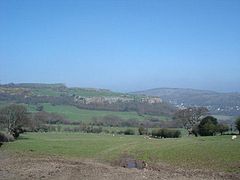 Cefn Castell | |
|---|---|
| Duw â digon (God is sufficient) | |
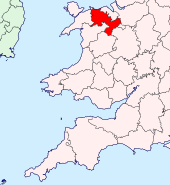
| |
| [Interactive map] | |
| Area: | 668 square miles |
| Population: | 277,680 |
| County town: | Denbigh |
| County flower: | Limestone woundwort [1] |
The County of Denbigh is a shire in northern Wales. It is a maritime county, bounded to the north by the Irish Sea, to the east by Flintshire, Cheshire and Shropshire, to the south by Montgomeryshire and Merionethshire, and to the west by Caernarfonshire.
Denbigh, after which the county is named, is the county town, but the largest town is the industrial town of Wrexham at the south-east edge of the shire, near the Shropshire border. All along the coast are nineteenth-century seaside resorts, such as Colwyn Bay, and these continue as such today.
The most important industries in Denbighshire are agriculture and tourism.
Geography

In the south and west of the county are high mountains of the Cambrian range. The hills of the Clwydian Range in the east of the shire rise from 1,000 to 2,500-feet high. There is in contrast a broad coastal plain on which many of the county's towns are found, and its famed seaside resorts.
The county top is the south summit of Cadair Berwyn, standing at 2,726 feet above sea level in the Cambrian Mountains, approaching Snowdonia, and it is in these hills that Denbighshire's highest mountains are found. Either side of the county top itself and on the same ridge are two summits mapped at equal height; Cadair Berwyn and Moel Sych to the south on the same ridge both at 2,713 feet.
The hills of the Clwydian Range are far more gentle but it is from these hills tumbles Pistyll Rhaeadr, a spectacular 240-foot waterfall, the highest in Wales. On the ridge of these hills runs the border with Flintshire.
In the south the Clocaenog Forest reaches its highest and wildest on the Denbigh Moors or Mynydd Hiraethog.
The chief rivers of Denbighshire are the River Clwyd and the River Dee. The River Conwy runs north along the western border.
The broad, fertile Vale of Clwyd runs south to north at the west side of Denbighshire.
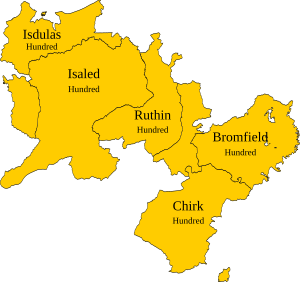
The county is divided into six hundreds:
History
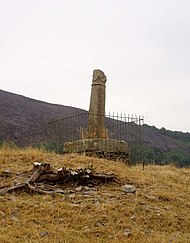
The Romans were here; they had a fort at Abergele.
After the Roman retreat, these lands fell to the Kingdoms of Powys and Gwynedd. One remarkable remaining monument of the Sub-Roman period is the Pillar of Eliseg, near Valle Crucis Abbey (SJ204442) erected by Cyngen ap Cadell King of Powys (died 855), in honour of his great-grandfather Elisedd ap Gwylog, the inscription of which mentions several individuals described in the Historia Britonum and give a brief history of the deeds of the dynasty.
After the English conquest of North Wales, Denbighland was divided into marcher lordships: Bromfield and Yale, Chirk, Denbigh and Ruthin (Dyffryn Clwyd)
The County or Shire of Denbigh was formally created by the Laws in Wales Acts 1535-1542, out of the lands long known as "Denbighland".[1]
Within the county are the following historic cantrefs:
- From the Kingdom of Gwynedd:
- Rhos
- Rhufoniog
- Dyffryn Clwyd
- From Powys Fadog:
- Iâl
- Maelor Gymraeg
- Nanheudwy
- Cynllaith
Towns and villages
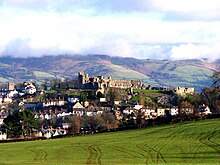
The towns of Denbighshire are:
Cities
Towns
Civil communities
- Abenbury
- Abergele
- Aberwheeler
- Acton
- Betws Yn Rhos
- Bro Garmon
- Brymbo
- Bryneglwys
- Caia Park
- Cefn
- Cefnmeiriadog
- Ceiriog Ucha
- Cerrigydrudion
- Chirk
- Clocaenog
- Coedpoeth
- Colwyn Bay
- Cyffylliog
- Denbigh
- Derwen
- Efenechtyd
- Eglwysbach
- Erbistock
- Esclusham
- Glyntraian
- Gresford
- Gwersyllt
- Henllan
- Holt
- Isycoed
- Kinmel Bay and Towyn
- Llanarmon-yn-Ial
- Llanbedr Dyffryn Clwyd
- Llanddulas and Rhyd-y-Foel
- Llandegla
- Llandyrnog
- Llanelidan
- Llanfair Dyffryn Clwyd
- Llanfair Talhaiarn
- Llanferres
- Llanfihangel Glyn Myfyr
- Llangedwyn
- Llangernyw
- Llangollen
- Llangollen Rural
- Llangwm
- Llangynhafal
- Llannefydd
- Llanrhaeadr-ym-Mochnant
- Llanrhaeadr-Yng-Nghinmeirch
- Llanrwst
- Llansanffraid Glan Conwy
- Llansannan
- Llansantffraid Glyn Ceiriog
- Llansilin
- Llantysilio
- Llanynys
- Llay
- Llysfaen
- Marchwiel
- Minera
- Mochdre
- Nantglyn
- Offa
- Old Colwyn
- Pentrefoelas
- Penycae
- Rhos-on-Sea
- Rhosddu
- Rhosllanerchrugog
- Rossett
- Ruabon
- Ruthin
- Sesswick
- Trefnant
Things to see in Denbighshire
| Key | |
| Cathedral/Abbey/Priory | |
| Accessible open space | |
| Amusement/Theme Park | |
| Castle | |
| Country Park | |
| Cadw | |
| Forestry Commission | |
| Heritage railway | |
| Historic House | |
| Museum (free/not free) | |
| National Trust | |
| Zoo | |
- Bodnant Garden, Tal-y-Cafn (SH7972);
 Chirk Castle (SJ2638)
Chirk Castle (SJ2638) Clocaenog Forest
Clocaenog Forest Denbigh Castle (SJ0565)
Denbigh Castle (SJ0565)- Pillar of Eliseg (SJ2044)
- Llangollen:
- Vale of Clwyd
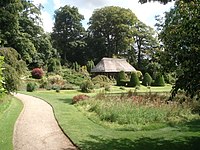
Outside links
References
| Counties of the United Kingdom |
|---|
|
Aberdeen • Anglesey • Angus • Antrim • Argyll • Armagh • Ayr • Banff • Bedford • Berks • Berwick • Brecknock • Buckingham • Bute • Caernarfon • Caithness • Cambridge • Cardigan • Carmarthen • Chester • Clackmannan • Cornwall • Cromarty • Cumberland • Denbigh • Derby • Devon • Dorset • Down • Dumfries • Dunbarton • Durham • East Lothian • Essex • Fermanagh • Fife • Flint • Glamorgan • Gloucester • Hants • Hereford • Hertford • Huntingdon • Inverness • Kent • Kincardine • Kinross • Kirkcudbright • Lanark • Lancaster • Leicester • Lincoln • Londonderry • Merioneth • Middlesex • Midlothian • Monmouth • Montgomery • Moray • Nairn • Norfolk • Northampton • Northumberland • Nottingham • Orkney • Oxford • Peebles • Pembroke • Perth • Radnor • Renfrew • Ross • Roxburgh • Rutland • Selkirk • Shetland • Salop • Somerset • Stafford • Stirling • Suffolk • Surrey • Sussex • Sutherland • Tyrone • Warwick • West Lothian • Westmorland • Wigtown • Wilts • Worcester • York |